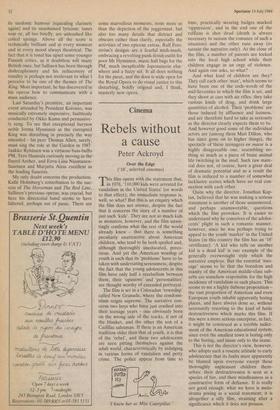Cinema
Rebels without a cause
Peter Ackroyd
Over the Edge ('18', selected cinemas) his film opens with the statement that, in 1978, '110,000 kids were arrested for vandalism in the United States' (or words to that effect); the immediate response is, well, so what? But this is an enquiry which the film does not answer, despite the fact that it concerns the story of a number of just such 'kids'. They are not so much kids as monsters, however, and the film unwit- tingly confirms what the rest of the world already knew — that there is something peculiarly unattractive about American children, who tend to be both spoiled and, although thoroughly uneducated, preco- cious. And yet the American worship of youth is such that its 'problems' have to be taken with undeviating seriousness; despite the fact that the young adolescents in this film have only half a cerebellum between them, their 'opinions' and 'personalities' are thought worthy of extended portrayal.
The film is set in a Coloradan 'township' called New Granada, where the condomi- nium reigns supreme. The narrative con- cerns two boys who have just crashed into their teenage years — one obviously born on the wrong side of the tracks, if not of the blanket, and the other the son of a Cadillac salesman. If there is an American tradition older than that of youth, it is that of the 'rebel', and these two adolescents are seen pitting themselves against the adult world, characteristically by indulging in various forms of vandalism and petty crime. The police appear from time to 'I knew her as Miss Caterpillar.'
time, practically wearing badges marked 'oppression', and in the end one of the ruffians is shot dead (death is always necessary to sustain the romance of such a situation) and the other runs away (to sustain the narrative only). At the close of the film, a number of parents are locked into the local high school while their children engage in an orgy of violence. And again one asks, so what?
And what kind of children are they? They call each other 'man', which seems to have been one of the code-words of the mid-Seventies in which the film is set, and they shoot at cars with air rifles; they take various kinds of drug, and drink large quantities of alcohol. Their 'problems' are those induced by affluence and laziness, and are therefore hard to take as seriously as the director clearly expects them to be. And however good some of the individual actors are (among them Matt Dillon, who has since gone on to higher things), the spectacle of 'these teenagers en masse is a highly disagreeable one, resembling no- thing so much as a piece of brute animal life twitching in the mud. Such raw mate- rial does not, of course, have a great deal of dramatic potential and as a result the film is reduced to a number of somewhat lacklustre scenes which have no real con- nection with each other.
Quite why the director, Jonathan Kap- lan, believed that he was making a serious statement is another of those unanswered, and perhaps unanswerable, questions which the film provokes. It is easier to understand why he conceives of the adoles- cents' plight in such a romantic manner, however, since he was perhaps trying to appeal to the youth 'market' in the United States (in this country the film has an '18' certificate): 'A kid who tells on another kid is a dead kid' is one example of the generally overwrought style which the narrative employs. But the essential 'mes- sage' seems to be that the boredom and inanity of the American middle-class sub- urbs are somehow responsible for the high incidence of vandalism in such places. This seems to me a highly dubious proposition the vast proportion of American and even European youth inhabit apparently boring places, and have always done so, without necessarily resorting to the kind of futile destructiveness which marks this film. If this were a more serious enterprise, in fact, it might be construed as a terrible indict- ment of the American educational system, since even the smallest town is boring only to the boring, and inane only to the inane.
This is not the director's view, however, who adopts such a roseate attitude to early adolescence that its faults must apparently be blamed upon everyone except these thoroughly unpleasant children them- selves: their destructiveness is seen as a species of fun, and their mindlessness as a constructive form of defiance. It is really not good enough: what we have is melo- drama posing as a social statement; it is altogether a silly film, straining after a significance which it does not possess.














































 Previous page
Previous page